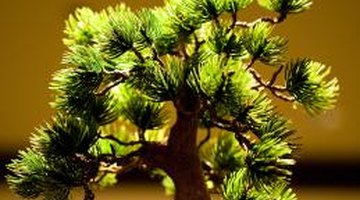What Type of Plaster to Use to Make a Base for an Artificial Tree?
Artificial trees are made to enhance decor without needing the attention a living plant requires. Often the smaller versions of these trees are called Ming or Bonsai trees and they are designed to look like dwarf trees on a miniature landscape. Some trees are made to look real but many are made from wire and beads or similar materials to look more like little pieces of jewelry. Larger trees are commonly used in displays at weddings. Making the artificial tree capable of standing on its own is done by using plaster and other materials.
Stability

When potting an indoor artificial tree, the most important consideration, outside of appearance, is for the tree to be stable inside its container so that it won't tip over easily. Usually creating this stability is a little more complicated than simply pouring plaster in a pot and sticking the trunk of the tree in the plaster. The trunk of many artificial plants may be made of plastic or a material with a greasy or slippery finish. These types of materials may not provide a good surface for the plaster to attach to. This means that when you lift up on the fake tree by the trunk, the trunk can simply pull out of the plaster.
Adding to the Stability
One way florists overcome stability problems is by inserting the trunk of the tree in floral foam or by drilling through the side of the trunk and inserting a stiff wire which they bend in a spiral shape to fit inside the dimensions of the container. The spiral can be screwed into foam or flattened and taped to the bottom of the container so that when plaster is added over the top, the tree will be unable to dislodge if pulled straight up.
Plaster of Paris
The most common plaster used for this type of simple mold is called plaster of Paris, 20-minute plaster or molding plaster. This is usually easy to find in craft stores. You need to wear a face mask when mixing the plaster as the dust is not healthy to breathe in. Using the plaster is simple. Prepare your tree and container first because the plaster hardens quickly. Mix your plaster in a disposable container, like a used milk carton. Place the plaster in the container and add small amounts of water, stirring constantly until the mixture is like pancake batter. Pour the plaster around the tree. The plaster will become hot, but this is normal.
Gypsum Cement
When working with larger trees and containers, 20-minute plaster is usually recommended as this will give you enough of a window for manipulating the plaster. But in some cases you may need more time. The next grade up of gypsum cement is sometimes called white plaster. This plaster has a slower setting time and the period of plasticity of the plaster is longer, allowing you to shift the tree slightly or in some cases to set river stones into the top of the plaster right before it hardens.
Writer Bio
F.R.R. Mallory has been published since 1996, writing books, short stories, articles and essays. She has worked as an architect, restored cars, designed clothing, renovated homes and makes crafts. She is a graduate of the University of California at Berkeley with bachelor's degrees in psychology and English. Her fiction short story "Black Ice" recently won a National Space Society contest.
Photo Credits
- Jupiterimages/Photos.com/Getty Images
More Articles



